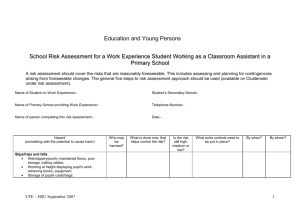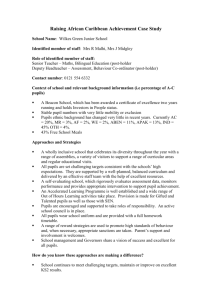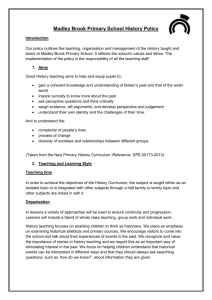Assessment Statement 18.11.14
advertisement
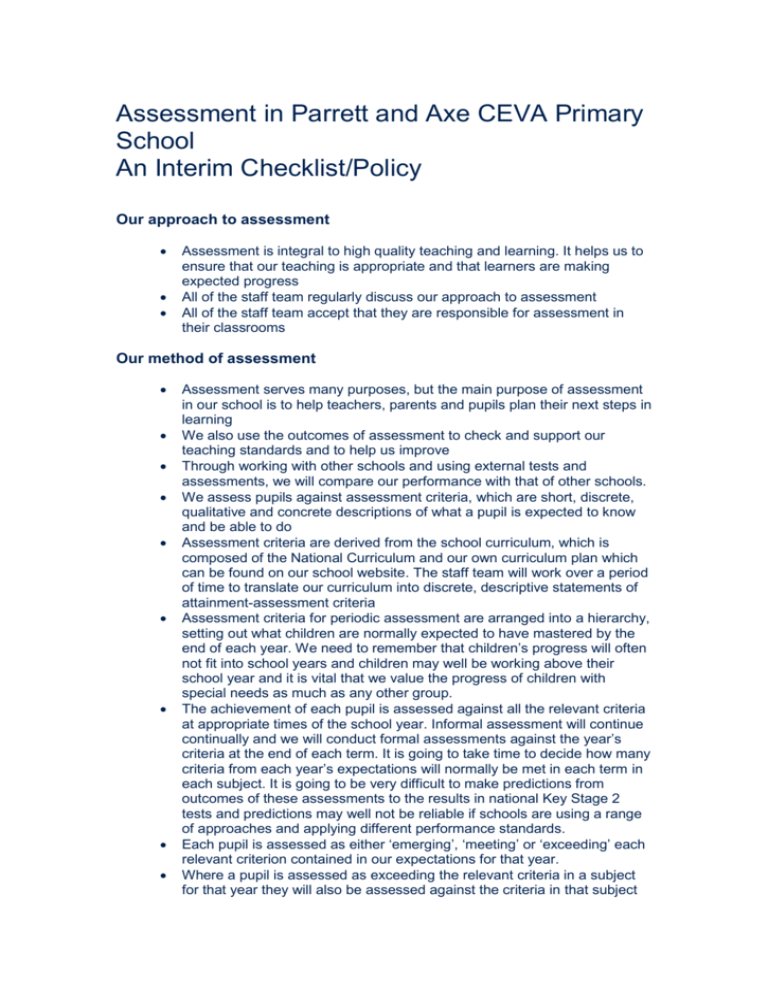
Assessment in Parrett and Axe CEVA Primary School An Interim Checklist/Policy Our approach to assessment Assessment is integral to high quality teaching and learning. It helps us to ensure that our teaching is appropriate and that learners are making expected progress All of the staff team regularly discuss our approach to assessment All of the staff team accept that they are responsible for assessment in their classrooms Our method of assessment Assessment serves many purposes, but the main purpose of assessment in our school is to help teachers, parents and pupils plan their next steps in learning We also use the outcomes of assessment to check and support our teaching standards and to help us improve Through working with other schools and using external tests and assessments, we will compare our performance with that of other schools. We assess pupils against assessment criteria, which are short, discrete, qualitative and concrete descriptions of what a pupil is expected to know and be able to do Assessment criteria are derived from the school curriculum, which is composed of the National Curriculum and our own curriculum plan which can be found on our school website. The staff team will work over a period of time to translate our curriculum into discrete, descriptive statements of attainment-assessment criteria Assessment criteria for periodic assessment are arranged into a hierarchy, setting out what children are normally expected to have mastered by the end of each year. We need to remember that children’s progress will often not fit into school years and children may well be working above their school year and it is vital that we value the progress of children with special needs as much as any other group. The achievement of each pupil is assessed against all the relevant criteria at appropriate times of the school year. Informal assessment will continue continually and we will conduct formal assessments against the year’s criteria at the end of each term. It is going to take time to decide how many criteria from each year’s expectations will normally be met in each term in each subject. It is going to be very difficult to make predictions from outcomes of these assessments to the results in national Key Stage 2 tests and predictions may well not be reliable if schools are using a range of approaches and applying different performance standards. Each pupil is assessed as either ‘emerging’, ‘meeting’ or ‘exceeding’ each relevant criterion contained in our expectations for that year. Where a pupil is assessed as exceeding the relevant criteria in a subject for that year they will also be assessed against the criteria in that subject for the next year. For those pupils meeting and exceeding the expected standards, we provide more challenging work Assessment judgements are recorded and backed by a body of evidence created using observations, records of work and testing Assessment judgements will be moderated by colleagues in school and by colleagues in other schools in the Beaminster Pyramid to make sure our assessments are fair, reliable and valid. Our use of assessment Teachers use the outcomes of our assessments to summarise and analyse attainment and progress for their pupils and classes Teachers use this data to plan the learning for every pupil to ensure they meet or exceed expectations. Teachers and subject leaders analyse the data across the school to ensure that pupils identified as vulnerable or at particular risk in this school are making appropriate progress and that all pupils are suitably stretched The information from assessment is communicated to parents and pupils on a termly basis. Parents and pupils receive summaries of what has been achieved and indications of what they need to do next We celebrate all achievements across a broad and balanced curriculum, including sport, art and performance, behaviour, and social and emotional development Notes and commentary on the above checklist The most natural choice of hierarchy for criteria is by school year (certainly the curriculum is usually organised into years and terms for planned delivery). However, children’s progress may not fit neatly into school years, so we have chosen the language of a hierarchy of expectations to avoid misunderstandings. Children may be working above or below their school year and we must ensure we value the progress of children with special needs as much as any other group. The use of P scales here is important to ensure appropriate challenge and progression for pupils with SEN. Our school may conduct formal assessments more than once a year and informal assessment will take place continually. A formal assessment at the end of each term, against the year’s criteria, is our natural pattern. It will take time before we can develop a sense of how many criteria from each year’s expectations will normally met in the autumn, spring and summer terms, and this will also vary by subject. Consequently it will also be hard to use this framework by itself for prioritising intervention in the first few years of use. For some years to come, it will be hard to make predictions from outcomes of these assessments to the results in KS2 tests. Such data may emerge over time, although there are question marks over how reliable predictions may be if different schools are using incompatible approaches and applying differing standards of performance and therefore cannot pool data to form large samples. There is a need to record a pupil’s attainment against each applicable assessment criterion. The criteria themselves can be combined to provide the qualitative statement of a pupil’s achievements, although we may need a quantitative summary. Few schools appear to favour a pure ‘binary’ approach of yes/no. The Beaminster Pyramid of schools has chosen a three phase judgement of Emerging, Developing and Secure. Where a child has exceeded a specific criterion, we will also assess them against the criteria for the next year. These recorded judgements may be translated into numbers, which can then be analysed and used for prioritising. Traffic lighting is our chosen method for monitoring. We have selected Green for Autumn Term, Pink for Spring Term and Blue for Summer Term and we will count the proportion of the relevant year’s criteria that have been met at a specific point in time. At this stage, it is not possible to say what proportions will be cause for concern or celebration at a particular time of the year - although presumably we will expect a child to have mastered all applicable criteria by the end of each academic year. The method of ‘fitting’ a student to a criterion must be consistent to draw comparisons between groups. The exact form of moderation will vary in our school from subject to subject. The majority of moderation will be internal but we will undertake a proportion of external moderation each year, working with partner schools and the Local Authority. We are aware that it is good practice to invite external agencies with no connection to our school to verify practice from time to time.
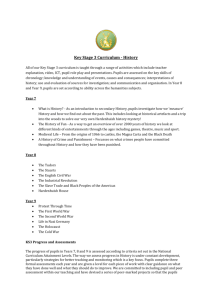
![Assessment commission - design checklist [docx / 102KB]](http://s3.studylib.net/store/data/007028345_1-8812ab654481f02d7080cca0f2e3a367-300x300.png)




![afl_mat[1]](http://s2.studylib.net/store/data/005387843_1-8371eaaba182de7da429cb4369cd28fc-300x300.png)
